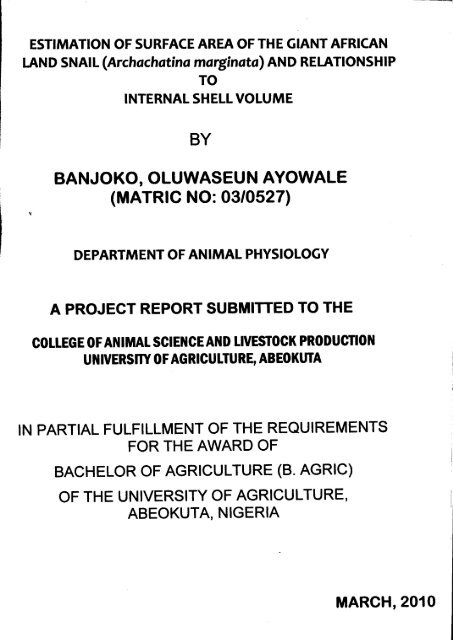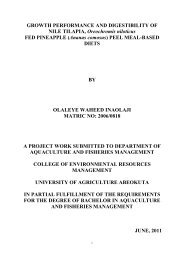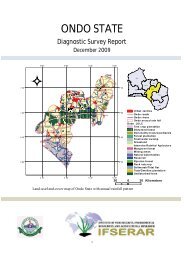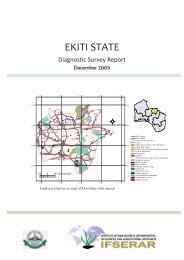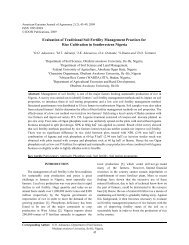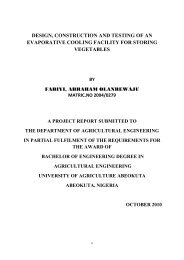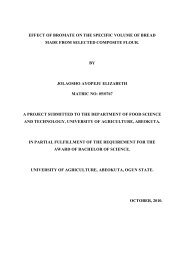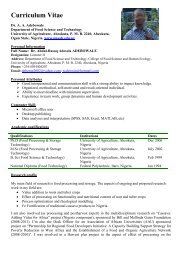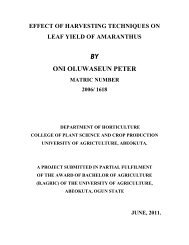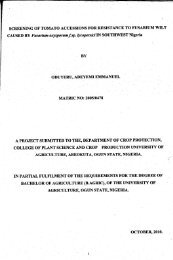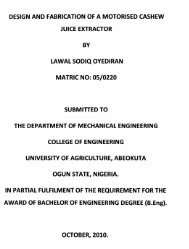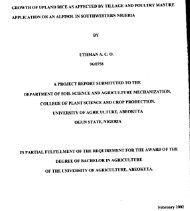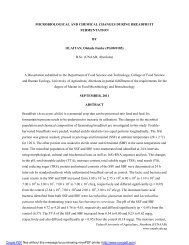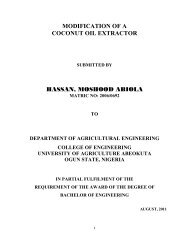LAND SNAIL (Archachatina marginata) - The Federal University of ...
LAND SNAIL (Archachatina marginata) - The Federal University of ...
LAND SNAIL (Archachatina marginata) - The Federal University of ...
You also want an ePaper? Increase the reach of your titles
YUMPU automatically turns print PDFs into web optimized ePapers that Google loves.
ESTIMATION OF SURFACE AREA OF THE GIANT AFRICAN<br />
<strong>LAND</strong> <strong>SNAIL</strong> (<strong>Archachatina</strong> <strong>marginata</strong>) AND RELATIONSHIP<br />
TO<br />
INTERNAL SHELL VOLUME<br />
BY<br />
BANJOKO, OLUWASEUN AYOWALE<br />
(MATRIC NO: 03/0527)<br />
A PROJECT REPORT SUBMITTED TO THE<br />
COLLEGE OF ANIMAL SCIENCE AND LIVESTOCK PRODUCTION<br />
UNIVERSnv OF AGRICULTURE, ABEOKUTA<br />
IN PARTIAL FULFILLMENT OF THE REQUIREMENTS<br />
FOR THE AWARD OF<br />
BACHELOR OF AGRICULTURE<br />
(B. AGRIC)<br />
OF THE UNIVERSITY OF AGRICULTURE,<br />
ABEOKUTA, NIGERIA<br />
MARCH, 2010
I express my unreserved appreciation to my Supervisor, Pr<strong>of</strong>essor O.A. Osinowo, for his<br />
understanding, guidance, suggestions, encouragement and constructive criticisms throughout<br />
the course <strong>of</strong> this prQject. I acknowledge the immense contributions, invaluable assistance<br />
and constructive criticisms <strong>of</strong> Dr. T.J. Williams, Dr. I.J. James, Dr. O.F. Smith and the Snail<br />
ResearchUnit Manager, Brother Ibrahim.<br />
I am also grateful to Mr. and Mrs. Bamidele, my brothers Ayorinde, Olusegun, Bolarinwa,<br />
and Opeyemi for their constant encouragement. Finally, to my ever loyal friends, Lizzy<br />
Olusanya, Yewande Okunlola, Hansome Macaulay, Tolu Laniran, Ejiro Layeni, Deji Abatan,<br />
Femi Akilapa and Debola Adefemi, I am deeply appreciative.
Twenty shells and eighty-two <strong>Archachatina</strong> <strong>marginata</strong> weighing between 88 and 485 g were<br />
sourced from Delta State, Edo State, Enugu State, Imo State and Abeokuta in Ogun State.<br />
<strong>The</strong> snails were measured for their shell parameters such as length, width, width <strong>of</strong> whorls,<br />
weight, surface area and internal shell volume to ascertain the degree <strong>of</strong> relationships<br />
between the said shell parameters. <strong>The</strong> weight <strong>of</strong> the snail was determined directly on a<br />
sensitive scale, shell height measured along its axis and shell width measured across it were<br />
also measured directly using a vernier caliper. <strong>The</strong> shell volume was obtained by filling the<br />
shellto the brim with water and subsequently measuring the water in a calibrated cylinder.<br />
<strong>The</strong> shell surface area was obtained using the grid svstem involvinl! Dlasterinl! <strong>of</strong> l!TaDh<strong>of</strong><br />
known area on the shell surface. <strong>The</strong> data obtained from the measurement <strong>of</strong> the<br />
;<strong>Archachatina</strong> <strong>marginata</strong><br />
shells were subjected to Pearson correlation matrix to determine the<br />
degree <strong>of</strong> association between the shell parameters. It was discovered that length and width<br />
were highly correlated (P
Title page<br />
Certification<br />
Dedication<br />
Acknowledeement<br />
Abstract<br />
Table <strong>of</strong> contents<br />
List <strong>of</strong> tables<br />
List <strong>of</strong> fieures<br />
CHAPTERONE<br />
1.0 INTRODUCTION<br />
1.1 Broad objective<br />
1.2 Specific objectives<br />
CHAPTER TWO<br />
2.0 LITERATURE REVIEW<br />
2.1 Anatomy <strong>of</strong> snail<br />
2.2 Morphology <strong>of</strong> snail shell<br />
2.3 Description <strong>of</strong> <strong>Archachatina</strong> <strong>marginata</strong><br />
2.4 Relationship between surface area and internal shell volume<br />
2.5 Importance <strong>of</strong> snail surface area to volume ratio<br />
2.6 Composition <strong>of</strong> snail shell<br />
2.7 Development <strong>of</strong> a shell<br />
2.8 Shell colour formation<br />
2.9 Importance <strong>of</strong> snail shell
COlluueroial uses for snail shells<br />
Feed<br />
Feeding methods<br />
Sanitation and hygiene<br />
MATERIALS AND METHODS<br />
Experimental area<br />
Experimental animals and management<br />
Experimental materials<br />
Methodoloav<br />
Data collection<br />
Statistical analysis<br />
4.0 RESULTS AND DISCUSSION 15<br />
4.1 Correlation matrix <strong>of</strong> shell parameters 15<br />
4.1.1 Relationship between shell length and shell surface area 16<br />
4.1.2 Relationship between shell width and shell surface area 17<br />
4.1.3 Relationship between shell length and shell internal volume 18<br />
4.1.4 Relationship between shell width and shell internal volume 19<br />
4.1.5 Relationship between shell surface area and shell internal volume 20<br />
4.2 Regression <strong>of</strong> shell length, shell width and whorl width on ~hell surface area 21<br />
4.3 Regression <strong>of</strong> shell length, shell width and whorl width on internal shell volume 23<br />
4.4 Validation <strong>of</strong> predictive equation using independent data 24
CHAPTER FIVE<br />
5.0 CONCLUSIONS AND RECOMMENDATIONS<br />
APPENDIX<br />
A: Shell parameters <strong>of</strong> dead <strong>Archachatina</strong> <strong>marginata</strong><br />
8: Shell parameters <strong>of</strong> live <strong>Archachatina</strong> <strong>marginata</strong>
Correlation matrix <strong>of</strong> shell volume and surface area with linear<br />
values <strong>of</strong> shell parameters <strong>of</strong> <strong>Archachatina</strong> <strong>marginata</strong><br />
Regression equations <strong>of</strong> surface area with linear values <strong>of</strong> shell<br />
Parameters<br />
Regression equations <strong>of</strong> shell volume with linear values <strong>of</strong><br />
shell parameters<br />
Summary <strong>of</strong> analysis <strong>of</strong> variance between the actual width and<br />
the predicted width
Figure 1 Relationship between shell length and surface area 16<br />
Figure 2 Relationship between shell width and surface area 17<br />
Figure 3 Relationship between shell length internal shell volume 18<br />
Figure 4 Relationship between width and internal shell volume 19<br />
Figure 5 Relationship between shell surface area and internal shell volume 20<br />
Figure 6 Comparison <strong>of</strong> actual and predicted shell width 25
CHAP'fERONE<br />
INTRODUCTION<br />
<strong>The</strong> snail coupled with other small livestock species such as grasscutter, giant rat constitute<br />
"micro-livestock", a new but rapidly expanding area <strong>of</strong> animal production and research. <strong>The</strong><br />
snail gained increased attention in recent years as a result <strong>of</strong> augmenting family income. <strong>The</strong><br />
snail forms a common component <strong>of</strong> food in the diet <strong>of</strong> people, rich in protein (88.37%) thus<br />
compares well with conventional animal protein sources; beef (92.75%), broiler (92.21%),<br />
chevon (86.63%), mutton (86.34%), pork (82.42%) and fishes (91.99% and 90.81%)<br />
(Imevbore and Akinnusi, 1988). <strong>The</strong> snail also possess curative properties (Cobbinah, 1990<br />
and Akinnusi, 1998), an area which require further investigation so as to gain wide scale<br />
application.<br />
Snails are bilaterally symmetrical invertebrates with s<strong>of</strong>t unsegmented body enclosed by an<br />
exoskeleton in the form <strong>of</strong> calcareous shell. <strong>The</strong>y belong to the phylum Mollusca, <strong>of</strong> class<br />
Gastroooda. subclass Pulmonata. order StvlommatoDhora and familv Achatinidae. which is<br />
the Giant African Land Snail. Snail meat feature in the diets <strong>of</strong> urban and rural dwellers in the<br />
southern part <strong>of</strong> Nigeria, usually served as delicacies, and occasionally for health<br />
consideration. Akinnusi (1996) stated the main source <strong>of</strong> supply to the numerous consumers<br />
is from people who gather wild snails from nearby bushes and sell along the roadsides and in<br />
the local markets. Hodasi (1979), Akinnusi (1998) and Orisawayi (1989) put the age at sexual<br />
maturity at six (6) months when they are reared from day-old but in the wild it is between<br />
nine (9) to ten (10) months.<br />
A snail's body is characterized by a division into a s<strong>of</strong>t body and a hard shell. <strong>The</strong> shell is<br />
secreted by a part <strong>of</strong> the molluscan body known as the mantle. <strong>The</strong> snail shell is an external
skeleton or exoskeleton, which serves not only for muscle attachment, but also for protection<br />
from predators and from mechanical damage. In land snails, the shell is an essential<br />
protection against the sun, and against drying out.<br />
In land snails, shells <strong>of</strong>ten provide relevant morphometric<br />
data used in taxonomy and<br />
phylogenetic inference as well as in population biology. Shell morphology (which preserves<br />
the ontogenic record <strong>of</strong> growth) is the principal su~ject <strong>of</strong> theoretical morphology. This has<br />
led to studies on the formal and historical determinants <strong>of</strong> shell forms, as well as functional<br />
interpretations <strong>of</strong> their observed distributions (Raup, 1966; Stone, 1996, 1999; McGhee Jr.,<br />
1999; Samadi et al., 2000). Body size can be estimated as shell volume which is a more<br />
reliable measurement <strong>of</strong> land snail size than liveweight because this depends on the state <strong>of</strong><br />
hydration and is consequently highly variable in land snails (Baur and Baur, 1998).<br />
<strong>The</strong> most frequently used measurements <strong>of</strong> the snail shell are: the height <strong>of</strong> the shell, width <strong>of</strong><br />
the shell, height <strong>of</strong> the aperture, and width <strong>of</strong> the aperture. <strong>The</strong> number <strong>of</strong> whorls is also <strong>of</strong>ten<br />
used. Relative aperture area tends to be smaller under drier conditions, probably because <strong>of</strong><br />
selection for smaller whorl cross-sectional area to reduce water loss. Larger snails tend to<br />
have higher whorl expansion rates (Goodfriend, 1984). <strong>The</strong> largest height (also known as<br />
length) <strong>of</strong> any shell is found in marine snail species (Wells et al., 2003).<br />
<strong>The</strong>re is at present a lack <strong>of</strong> information in the literature on estimation <strong>of</strong> surface area <strong>of</strong> the<br />
giant African land snail and relationship to internal shell volume.<br />
1.1 Broadobjective<br />
• To determine the relationship between surface area and internal shell volume <strong>of</strong> the<br />
Giant African Land Snail (<strong>Archachatina</strong> <strong>marginata</strong>).
1.1 SpecificObjectives<br />
• To detennine the relationship between length and surface area <strong>of</strong> A. <strong>marginata</strong>..<br />
• To detennine the relationship between width and surface area <strong>of</strong> A. <strong>marginata</strong>.<br />
• To detennine the relationship between length and internal shell volume <strong>of</strong> A.<br />
<strong>marginata</strong>.<br />
• To detennine the relationship between width and internal shell volume <strong>of</strong> A.<br />
<strong>marginata</strong>.<br />
• To detennine the relationship between width <strong>of</strong> each whorl, shell surface area and<br />
internal shell volume <strong>of</strong> A. <strong>marginata</strong>.
CHAPTER TWO<br />
LITERATURE<br />
REVIEW<br />
%.1 Anatomy <strong>of</strong> the snail<br />
Snails are s<strong>of</strong>t-bodied animals consisting <strong>of</strong> two parts. the body and the shell.<br />
<strong>The</strong> body is divided into three parts. <strong>The</strong> head, the foot and the visceral mass which are all<br />
encapsulated by the shell. the wall <strong>of</strong> the shell is lined by the fleshy mantle. <strong>The</strong> head is in the<br />
front part <strong>of</strong> the body. and it is easily noticeable. It is consisted <strong>of</strong> the mouth and four<br />
tentacles <strong>of</strong> which the upper pair is longer. <strong>The</strong> head bears two tentacles that can be retracted.<br />
<strong>The</strong> upper pair is longer than the lower pair (Roberts, 2000). Each pair <strong>of</strong> the tentacles has a<br />
tiny eye at the tip. <strong>The</strong> eye is used to distinguish light and darkness. <strong>The</strong> two shorter tentacles<br />
are knobbed at the tips and are the organs <strong>of</strong> smell and touch. <strong>The</strong> mouth is located at the<br />
centre <strong>of</strong> the head. <strong>The</strong> mouth opens directly into the a muscular cavity lined with a horny<br />
jaw and a radula flexible file-like rasping organ with numerous row <strong>of</strong> muscular teeth for<br />
shredding food (Akinnusi. 1998). <strong>The</strong> foot, protruding from the shell. allows movement and<br />
sticking <strong>of</strong> the snail to the ground. <strong>The</strong> bottom part <strong>of</strong> the foot contains many glands that<br />
secrete slime thus creating visible silvery trace. Thanks to that the snail can slide over a<br />
rnzor's edge without hurting itself. Its movements are slow but strong. <strong>The</strong> lower part <strong>of</strong> the<br />
foot is made <strong>of</strong> strong muscles. <strong>The</strong> visceral mass, which is the s<strong>of</strong>test part, is confined within<br />
the upper whorls <strong>of</strong> the shell. It is humped shaped and generally holds the bulk <strong>of</strong> the<br />
digestive. reproductive. excretory and respiratory system. <strong>The</strong> skink <strong>of</strong> the visceral hump<br />
secretes a large calcareous shell.<br />
<strong>The</strong> typical snail has a calcareous shell coiled in a spiral pattern around has a central axis or<br />
columella. <strong>The</strong> shell in secreted by the fleshy living <strong>of</strong> the wall <strong>of</strong> the shell known as the<br />
mantle. <strong>The</strong> secretion <strong>of</strong> the shell in by outward additions to the shell hip and then by<br />
secretion <strong>of</strong> inner thickening layers. <strong>The</strong> outer layer <strong>of</strong> the shell in a mixture <strong>of</strong> proteins
known as conchin. Inner layers <strong>of</strong> the shell is made up <strong>of</strong> calcium carbonate join with a<br />
network <strong>of</strong> conchin and are impregnably with variety <strong>of</strong> mineral salt Cobbinah (1990)<br />
submitted that 98% <strong>of</strong> the shell is in the form <strong>of</strong> calcium carbonate.<br />
Snail shells are important for use in systematic, that is deciding who is more closely to whom.<br />
<strong>The</strong> conical, planospiral and spire are the three shell shaPes, all <strong>of</strong> which have different<br />
structural strengths. Most snails have a roughly conical or oval shell protecting their bodies.<br />
<strong>The</strong>se shells are twisted into spiral levels known as whorls. <strong>The</strong> whorls are largest at the base<br />
and each one gets progressively smaller as we approach the tip, known as the apex. Notice<br />
that there is a large opening in the newest whorl <strong>of</strong> the snail. This is called an aperture. <strong>The</strong><br />
inside edge is called the inner lip and the outside edge is the outer lip. <strong>The</strong>se aperture lips are<br />
where new shell material is added. Also, the newest whorl containing the aperture is called<br />
the body whorl. <strong>The</strong> whorl is a complete turn <strong>of</strong> the shell. All the older whorls above this one<br />
are collectively called the spire.<br />
<strong>The</strong> whorls form as shell material is laid down by the mantle, which is a sheet-like organ that<br />
lies against the inside <strong>of</strong> the largest bottom whorl. <strong>The</strong> rod shaped structure that runs down<br />
the centre <strong>of</strong> the shell is called columella. One additional feature <strong>of</strong> some snail shells is that<br />
tubular structure at the very end. This is called the aperture canal and is used to house and<br />
protect the animal's siphon, which is like a nose that is used to search for food. Obviously the<br />
primary use <strong>of</strong> the shell is to protect the s<strong>of</strong>t body inside. But since the animal must be able to<br />
extend part <strong>of</strong> its body from the shell in order to move around and eat, the aperture represents<br />
a pretty large chink in the snail's armor. To protect this opening there is a structure attached<br />
to the foot called an operculum. This trap-door structure seals the opening shut when the foot<br />
is retracted back into the shell. This not only prevents predators' access, but for intertidal<br />
5
species it protects them from drying out during low tide. <strong>The</strong> moon snail (top) has a hole in<br />
the boUom. This is called an umbilicus and is where the mantle inserts calcium to form the<br />
central columella. <strong>The</strong> suture is an indentation seperating the whorls.<br />
2~ D~riptionorA.nmrgbmm<br />
According to Ogunlakin (1999) quoting Hodasi (1984) and Imevbore (1990), the A.<br />
<strong>marginata</strong> have a wide, bulbous or dome shaped apex <strong>of</strong> shell. <strong>The</strong>y produce few and<br />
relatively large eggs. <strong>The</strong>y have short and tubular vagina. <strong>The</strong> spermatheca duct is very long<br />
and slender. <strong>The</strong> pedal sole is relatively narrow and the shell colouration is irregular and has<br />
no definite pattern. Adult shell height is usually 140-170 mm. Shell pattern and colour varies,<br />
but is usually dark brown with varying amounts <strong>of</strong> lighter brown and yellow stripes. Flesh<br />
colour varies from light brown to almost black. <strong>The</strong>re are many white and pale-fleshed<br />
specimens in captivity too. <strong>The</strong> flesh feels quite coarse to the touch. <strong>The</strong>y make very good<br />
pets, but do prefer damper conditions. <strong>The</strong> species is native to central western Africa (around<br />
Cameroon).<br />
2.4 Relationship between surface area and internal shell volume<br />
Surface area is the area <strong>of</strong> a given surface. Roughly speaking, it is the "amount"<br />
<strong>of</strong> surface<br />
i.e, it is proportional to the amount <strong>of</strong> sheets needed to cover it (Fjelstad and Ginsher, 2003).<br />
<strong>The</strong> volume <strong>of</strong> A. <strong>marginata</strong> measures the space that it's body mass occupies.<br />
<strong>The</strong>' snail shell surface area and volume do not necessarily increase or decrease proportionally<br />
to increases or decreases in length, width, and weight. For example, the greater the diameter<br />
<strong>of</strong> a single-celled organism, the less surface area it has relative to its volume. <strong>The</strong> snail<br />
surface area to volume ratio is a way <strong>of</strong> expressing the relationship between these parameters<br />
as the snail size changes.
Organisms exhibit a variety <strong>of</strong> modifications, both physiological and anatomical, to<br />
compensate for changes in the surface area to volume ratio associated with size differences.<br />
One example <strong>of</strong> this is the higher metabolic rates found in smaller (homeothermic) animals.<br />
Because <strong>of</strong> their large surface area relative to volume, small animals lose heat at much higher<br />
rates than large animals, and therefore must produce more heat to <strong>of</strong>fset the effects <strong>of</strong> thermal<br />
conductance. Another example is the variety <strong>of</strong> internal transport systems that have developed<br />
in plants and animals for actively moving materials throughout the organism, thus enabling<br />
them to circumvent the limits imposed by passive diffusion. Many organisms have developed<br />
structures that actually increase their surface area: the leaves on trees, the microvilli on the<br />
lining <strong>of</strong> the small intestine, root hairs and capillaries (Vogel, 1988).<br />
2.5 Importance <strong>of</strong> snail surface area to volume ratio<br />
Changes in the snail's surface area to volume ratio have important implications for limits or<br />
constraints on the snail's size, and help explain some <strong>of</strong> the modifications seen in largerbodied<br />
organisms (Schmid-Nielson, 1984).<br />
<strong>The</strong> inside <strong>of</strong> the shell is crystallized calcium carbonate mixed with protein. <strong>The</strong> calcium is<br />
absorbed from the snail's food and from the surrounding water. Basically, the shell consist <strong>of</strong><br />
calcuim cabonate crystal organise within a matrix prottein.calcuim cabonate crystalizes in two<br />
principal forms aragonite and calcite, but calcite as also been found in repaired areas <strong>of</strong> shell<br />
(Saleuddin and Wilbur 1969). Snails living in environments wit!t high amount <strong>of</strong> calcium will<br />
grow thicker shells than those that do not. When there only small amount <strong>of</strong> calcium available<br />
in water, the snail has to spend much more energy to build its shell, so it only makes the
minimum thickness required to survive. <strong>The</strong> shells <strong>of</strong> many aquatic as well as land snaill are<br />
ooverd on the outside by a hard skin-like layer <strong>of</strong> protein that is called the periostracum. <strong>The</strong><br />
periostracum <strong>of</strong> marine snails, sometimes growing quite thick, helps protect the underlining<br />
shell from dissolving, especially in cold water in which the solubility <strong>of</strong> calcuim carbonate<br />
increses (Vermeij, 1993).<br />
<strong>The</strong> shell grows gradually over the lifetime <strong>of</strong> the snail by the addition <strong>of</strong> calcium carbonate<br />
to the leading edge or opening, and thus the shell gradually becomes longer and wider, in an<br />
increasing spiral shape, to better accommodate the growing animal inside. <strong>The</strong> animal also<br />
thickens the shell as it grows, so that the shell stays proportionately strong for its size. A<br />
snails shell is formed, repaired and maintained by a part <strong>of</strong> the anatomy called the mantle.<br />
Any injuries to or abnormal conditions <strong>of</strong> the mantle are usually reflected in the shape and<br />
form and even color <strong>of</strong> the shell. When the animal encounters harsh conditions which limit its<br />
food supply, or otherwise cause it to become dormant for a while, the mantle <strong>of</strong>ten ceases to<br />
produce the shell substance. When conditions improve again and the mantle resumes its task.<br />
a "growth line" which extends the entire length <strong>of</strong> the shell is produced, and the pattern and<br />
even the colors on the shell after these dormant periods are sometimes quite different from<br />
previous colors and pattern.<br />
<strong>The</strong> outer edge <strong>of</strong> a mollusc's mantle contains glands that secrete color pigments during shell<br />
formation. <strong>The</strong>se pigments control the colors on the outside <strong>of</strong> the shell. <strong>The</strong> iridescence on<br />
the inside <strong>of</strong> the shell is caused by alternating layers <strong>of</strong> calcite and and aragonite refracting<br />
different wavelengths <strong>of</strong> light by different amounts depending on the viewing angle. Colour
<strong>of</strong>fers a seamless installation. and there is no limit to the sheet size. Mother <strong>of</strong> pearl sheets<br />
may used on interior floors, exterior and interior walls, countertops, doors and ceilings.<br />
Insertion into architectural elements, such as columns or furniture is easily accomplished.<br />
2.11 Feeds<br />
<strong>The</strong> Achatinidae are herbivorous and feed on a wide variety <strong>of</strong> plants. <strong>The</strong> feed <strong>of</strong> snails vary.<br />
Snails have remarkable ability for converting dead and decaying plant into highly nutritious<br />
flesh. Nutrition plays a major role in snail growth. <strong>The</strong>y achieve the highest growth and<br />
reproductive rates with food sources <strong>of</strong> approximately 50% green leafy materials and 50%<br />
carbohydrate / animal protein supplemented with brewer's yeast and 3-4% calcium<br />
(Alexander, 1997). Adult snails eat tender flower and vegetable plants, decomposing plant<br />
parts and some fruits. Snails <strong>of</strong> all ages can eat plants such as lettuce, cauliflower, cabbage.<br />
egg plant, taro, banana, pineapple, and pawpaw (Akinnusi, 1998). Oyedokun, (2002) reported<br />
that snails fed with compound rations <strong>of</strong> 0.2% salt inclusion had higher feed conversion<br />
ratios, early attainment <strong>of</strong> sexual maturity and reduction in the length <strong>of</strong> time required to<br />
attain market size. Sufficient calcium for shell formation is a particular problem in snail<br />
transparent- Lack <strong>of</strong> calcium can also lead to stunting and infertility. Ground oyster shell or<br />
agricultural line makes excellent calcium sources. Other sources <strong>of</strong> calcium include bone<br />
meal, chalk and egg shell (Alexander, 1997).<br />
2.12 Feeding methods<br />
Snails are nocturnal animals because they are more active at night. Thus, the tendency has<br />
always been to restrict feeding and other maintenance activities till the evening and early<br />
hours <strong>of</strong> the night. Snails can feed at any time <strong>of</strong> the day especially when fed their specially<br />
preferred feeds such as unripe pawpaw fruits and wet chaff from fermented milled maize
(Aklftftusi, 1995). Alexander (1997) stated that exposure <strong>of</strong> the snails to continuous light at<br />
night increased their activity and rate <strong>of</strong> food consumption, thus promoting their rapid<br />
growth. Though snails are nocturna~ they do not feed continuously throughout the night.<br />
<strong>The</strong>ir feeding is sporadic, interspersed with exploratory movements or rest periods. Thus, less<br />
food would be consumed at normal darkness hours, which make snails reared under perpetual<br />
darkness to grow less than those reared under perpetual light (Hodasi, 1982).<br />
2.13 Sanitation and hygiene<br />
According to Alexander (1997), all decaying food should be removed promptly and the cage<br />
should be completely cleaned at least once a week. Slime and faeces should be wiped <strong>of</strong>f the<br />
cage with a wet material. If high stocking density rates are used, the soil will become<br />
saturated with faecal matter and slime. <strong>The</strong> soil should therefore be renewed once in a month.<br />
To provide the optimum humidity and temperature for breeding snails, a three layered<br />
substrate is recommended- a bottom layer <strong>of</strong> gravel and water, a second layer <strong>of</strong> moist soil<br />
and a third layer <strong>of</strong> dry leaflitter. Small earthworm can be introduced to help turn the soil and<br />
keep the soil aerated. Care should be taken when handling snails. Gloves should be worn<br />
during feeding and gathering (Alexander, 1997).
3.1 Experimental area<br />
<strong>The</strong> research was carried out at the Physiology Laboratory, College <strong>of</strong> Animal Science and<br />
Livestock Production (COLANIM) and Snail Research unit, <strong>University</strong> <strong>of</strong> Agriculture~<br />
Abeokuta, Ogun State. <strong>The</strong> location lies within the rainforest belt <strong>of</strong> Western Nigerian,<br />
latitude T'lO'N, longitude 3 0 2'E and altitude 76 0 mash. <strong>The</strong> climate is humid with a mean<br />
annual rainfall <strong>of</strong> 1,037 mm, mean temperature <strong>of</strong> 34.7 C, and a mean relative humidity <strong>of</strong><br />
82% (Google Earth, 2003).<br />
3.2 Experimental animals and management<br />
Twenty (20) shells and eighty-two (82) <strong>Archachatina</strong> <strong>marginata</strong> weighing between 88 g to<br />
485 g were used for the experiment. <strong>The</strong> snails were purchased from Delta State (88-289 g).<br />
Edo State (245-359 g), Imo State (131-279 g), Abeokuta, Ogun State (159-320 g) and Enugu<br />
State (213-485 g). <strong>The</strong> snails were housed in twelve (12) wooden cages filled with sun-dried<br />
top-humus to a depth <strong>of</strong> 5 cm, with Snails sourced from similar location being placed together<br />
in the same cage. <strong>The</strong> snails were provided with feed and drinking water both supplied ad<br />
libitum. <strong>The</strong> feed was a mixture <strong>of</strong>layers mash and dried pawpaw leaves (1:1, w/w). Feed and<br />
water troughs were washed daily, while the soil in each cage was changed bi-weekly.<br />
Collection <strong>of</strong> data through measurement <strong>of</strong> various shell parts for shell parameters was<br />
carried out on the snails.<br />
3.3 Experimental materials<br />
<strong>The</strong> materials used during the duration <strong>of</strong> the experiment include: sensitive scale, vernier<br />
caliper, measuring cylinder (250 ml), board pins, ruler, thread, washing bowl, detergent, plane<br />
sheets, snail (dam), snail shells, damp cloth and water.
3.4 )fethodology<br />
<strong>The</strong> experiment was conducted in two phases:<br />
Phase I:<br />
<strong>The</strong> phase was concerned. with the measurement <strong>of</strong> the live snails for their shell<br />
parameters. <strong>The</strong> snails were cleaned with a damp cloth to facilitate the removal <strong>of</strong><br />
dirt which may have glued to their shell and subsequently affect their weight. <strong>The</strong><br />
snails were placed on a sensitive scale one after the other to determine their<br />
weights, after which they were measured directly with the vernier caliper to<br />
determine their length and width. A thread was lined along the length <strong>of</strong> each<br />
whorl found on the snails shell to determine their width. This was possible by<br />
placing the thread along the length <strong>of</strong> a ruler.<br />
Phase II:<br />
It involved the collection <strong>of</strong> data from the shell <strong>of</strong> a dead snail (Adult) gathered<br />
through the measurement <strong>of</strong> the shell parts. <strong>The</strong> shells were properly washed with<br />
a detergent and rinsed with water to ensure that the shells were free <strong>of</strong> dirt and<br />
micro~organisms. <strong>The</strong> shells were measured for their length, weight, width and<br />
width <strong>of</strong> the whorls using the sensitive scale, vernier caliper, thread and a ruler.<br />
<strong>The</strong> internal volume <strong>of</strong> the shell was also noted. This was done by filling the shell<br />
to the brim with water after which the water contained in the shell was measure<br />
with a calibrated cylinder (250 ml).<br />
3.5 Data collection<br />
Seven shell measurements were taken in order to describe qualitatively the effect <strong>of</strong> other<br />
shell parameters on shell surface area and internal shell volume.<br />
(1) <strong>The</strong> weight (g)<br />
(2) <strong>The</strong> length (em)<br />
(3) <strong>The</strong> width (em)<br />
(4) <strong>The</strong> number <strong>of</strong> whorls on a snail<br />
(5) <strong>The</strong> whorl width (em)<br />
(6) <strong>The</strong> internal shell volume (mt)<br />
(7) <strong>The</strong> surface area (cm:t.)<br />
<strong>The</strong> weight was determined directly on a sensitive weighing scale. Shell height measured<br />
along the axis, and shell width measured across it, were also measured using a vernier caliper.<br />
<strong>The</strong> shell volume was obtained by filling the shells to the brim with water and subsequently
measuring the water contained within the shell in a calibrated cylinder. <strong>The</strong> shell surface area<br />
was determined<br />
using the grid system.<br />
3.6 Statistical analysis<br />
<strong>The</strong> data obtained were analyzed using Pearson correlation matrix to determine the degree <strong>of</strong><br />
association between shell parameters. Curvilinear regression and analysis <strong>of</strong> variance<br />
(ANOVA).<br />
<strong>The</strong> regression equation was expressed as Y =A+B(X),<br />
where Y= Dependent<br />
variable e.g. shell volume or surface area.<br />
A=Constant<br />
B=Regression<br />
X=Independent<br />
coefficient<br />
variable e.g. length, weight or width.
Table 1: Correlation matrix <strong>of</strong> shell volume and surface area with linear values<br />
<strong>of</strong> shell parameters <strong>of</strong> <strong>Archachatina</strong> <strong>marginata</strong><br />
Parameter Shell WT LTH WDT WW1 WW2 WW3 WW4 WW5 WW6<br />
volume<br />
Shell weight (WT) 0.777**<br />
Shell length (LTH) 0.889- 0.734*<br />
Shell width (WOT) 0.929*" 0.805" 0.819"<br />
it! wharf (WW1) 0.521 0.451 0.530 0.525<br />
2lld wholt (WW2) 0.661 0.569 0.679 0.587 0.574<br />
3"' vmorl (WW3) 0.670 0.654 0.788** 0.722* 0.643 0.495<br />
4th vmolt (WW4) 0.830- 0.761" 0.884- 0.819*** 0.544 0.659 0.756"<br />
5th vmorl (WW5) 0.606 0.557 0.754" 0.533 0.583 0.595 0.624 0.762**<br />
6'" vmorl (WW6) 0.853- 0.793" 0.835- 0.934- 0.473 0.419 0.616 0.706* 0.293<br />
Shell surface area 0.960"* 0.793" 0.835- 0.934*" 0.473 0.528 0.711 0.781* 0.490 0.886"*<br />
*P
whorl width six (WW6) having the highest correlation co-efficient (r) <strong>of</strong> 0.886 to the shell<br />
250 J<br />
18<br />
...•<br />
E 16<br />
•••<br />
to 200 14 E<br />
GI 12<br />
•••<br />
..<br />
150 ~<br />
III<br />
GI<br />
-..<br />
6<br />
III<br />
•••<br />
::J<br />
100<br />
8<br />
III<br />
Qj 50 4<br />
.c<br />
-SURFACEAREA -LENGTH<br />
II)<br />
2<br />
0 -~..,. , , ,-.-,--r 0<br />
1 2 3 4 5 6 7 8 9 10 1112 13 1415 16 17 18 19 20<br />
Snail shell tag number<br />
10<br />
•..<br />
tlII<br />
c<br />
.!!<br />
Qj<br />
.c<br />
II)
1 2 3 4 5 6 7 8 9 1011121314151617181920<br />
Snail shell tag number
4.1.3 Relationship between shell length and shell internal volume<br />
Figure 3 shows the relationship between shell length and shell internal volume to be a close<br />
one with a correlation co-efficient r = 0.889 and thus highly significant at 0.1% significance<br />
level.<br />
18<br />
16<br />
14<br />
12<br />
N<br />
Euai<br />
160<br />
E<br />
::s<br />
l<br />
~<br />
III<br />
1100<br />
~<br />
.i<br />
E<br />
10 "l<br />
.s::.<br />
!'<br />
~<br />
8 Qi<br />
.s::.<br />
III<br />
6<br />
4<br />
1 2 3 4 5 6 7 8 8 10 11 12 13 14 16 16 17 18 18 20<br />
Snail shell tag number<br />
Fig. 3. Relationship between length and internal shell volume
Figure 4.1.5 Relationship between shell surface area and shell internal volume<br />
Figure 5 shows the relationship between shell surface area and internal shell volume to be a<br />
nearly perfect one. Table 1 expressed the correlation co-efficient r = 0.960. <strong>The</strong> correlation<br />
was highly significant at 0.1% (P < 0.0001) significance level.<br />
1 2 3 4 5 6 7 8 9 10 11 12 13 14 15 16 17 18 19 20<br />
-VOLUME<br />
-SURFACE AREA
Table 2: Regression equations <strong>of</strong> surface area with linear values <strong>of</strong> shell parameters<br />
X y A B r r<br />
LTH SA -96.772 19.338 0.837 ***<br />
WTH SA -160.630 48.339 0.934 ***<br />
WWl SA 51.157 469.002 0.473 *<br />
WW2 SA 15.871 320.905 0.528 *<br />
WW3 SA -56.246 273.730 0.711 ***<br />
WW4 SA 76.974 182.150 0.781 ***<br />
WW5 SA 9.879 56.477 0.480 *<br />
WW6 SA -44.745 29.856 0.886 ***<br />
WWl-<br />
WW6<br />
SA<br />
SA<br />
Bl 29.052 0.922<br />
B232.109<br />
B345.507<br />
B415.260<br />
B511.934<br />
8623.765
with 83.70%. <strong>The</strong> multiple regressions between surface area and width <strong>of</strong> whorl one to six<br />
(WI-W6)<br />
was a good estimator <strong>of</strong> shell surface area at 0.1% significant level with a<br />
regression co-efficient <strong>of</strong> 92.22% but it is not as accurate or close an estimator when<br />
compared to that <strong>of</strong> width which has a regression co-efficient <strong>of</strong> 93.40%.<br />
Length (L): S = -96.77 + 19.34(L)<br />
Width (W): S = -160.63 + 43.34(W)<br />
Width <strong>of</strong> whorl six (W6): S = -44.75 + 29.86(W6)<br />
WI-W6: S = -101.62 + B(WI-W6)
.u Regression <strong>of</strong> shell length, shell width and whorl width on intemal sheDvol•••<br />
Table 3: Regression equations <strong>of</strong> shell volume with linear values <strong>of</strong> shell parameters<br />
X y A B r P<br />
LTH VOL -157.039 23.500 0.885 ***<br />
WTH VOL -212.992 55.208 0.929 ***<br />
WWl VOL 18.391 593.697 0.521 *<br />
WW2 VOL -47.031 461.633 0.661 **<br />
WW3 VOL -82.373 296.403 0.670 ***<br />
WW4 VOL -134.241 222.395 0.830 ***<br />
WW5 VOL -56.001 81.402 0.602 **<br />
WW6 VOL -74.205 33.037 0.853 ***<br />
WW1-<br />
WW6 VOL -167.801 BI39.719 0.944 ***<br />
B2135.258<br />
B3 -40.861<br />
B44.502<br />
B540.737<br />
B627.783<br />
W6 WTH 2.659 0.574 0.882 •••<br />
*P
(WW6) and width <strong>of</strong> whorl four (WW4) are also significant at 0.1% level <strong>of</strong> significance. <strong>The</strong><br />
multiple regression between shell volume (V) and width <strong>of</strong> whorl six (WW6) was the best<br />
estimator <strong>of</strong> internal shell volume at 0.1% level <strong>of</strong> significance with a regression co-efficient<br />
<strong>of</strong> 94.400,/0.It is more accurate an estimator than width (W) which has a regression coefficient<br />
<strong>of</strong> 92.29%.<br />
Length (L): V = -157.04 + 23.50(L)<br />
Width (W): V = -212.99 + 55.21(W)<br />
Source<br />
(lfOOP<br />
Error<br />
df MS<br />
f O.l34ns<br />
162 0.484<br />
Table 4 shows the summary <strong>of</strong> the analysis <strong>of</strong> variance between the actual and the predicted<br />
width. <strong>The</strong> regression equation between width <strong>of</strong> whorl six (WW6) and the width was used to<br />
generate the predicted width which was then related to the actual width <strong>of</strong> the eighty-two (82)<br />
snails. <strong>The</strong> table shows that there is no significant difference between the actual and predicted<br />
width.<br />
Actual width (n=82): 5.911±O.077cm<br />
Predicted width (n=82):5.968±O.077cm
<strong>The</strong> expression shows that the average widths (5.911 and 5.968) for the actual and<br />
width are very close.<br />
predicted<br />
9 I<br />
8 1<br />
: :I<br />
~ 4.~<br />
ci 3<br />
2·<br />
1 :<br />
o iTTTTili-rTT-r1"1---r-l---1'TTTTTT"T--r'r'ir-rliTTrrT'rrTT-Tl"l"T<br />
~rl"T'Trl"T'TTTT--l'TT-rT'1-rT-T-r-T"T-1"-1-r-rrTTTTTTTTTTl
From this study, it can be concluded that length, width as well as the whorls width have<br />
significant effect or are good estimators <strong>of</strong> the surface area <strong>of</strong> A. <strong>marginata</strong> with the most<br />
significant <strong>of</strong> the whorl width been the whorl width six (6). It can also be concluded that a<br />
positive and significant relationship exists between the surface area and the shell volume.<br />
It is therefore recommended that the length, width and width <strong>of</strong> the whorls especially that <strong>of</strong><br />
whorl six (6) be used as estimators for surface area and internal shell volume <strong>of</strong> A. <strong>marginata</strong><br />
It is also recommended that the surface area be used as a parameter for selecting shell volume<br />
for A. <strong>marginata</strong> and vice-versa.<br />
<strong>The</strong> surface area and shell volume should be used as parameters for selecting body size in<br />
land snails. This is because the body size can be estimated as s~eU volume which is a more<br />
reliable measurement <strong>of</strong> land snail size than live-weight because this depends on the state <strong>of</strong><br />
hydration and is consequently highly variable in land snails (Baur and Baur, 1998).
REFERENCES<br />
Akinnusi, 0.1995.<br />
Snail fanning research-practical experience <strong>of</strong> cage rearing <strong>of</strong>A. achatina<br />
and A. <strong>marginata</strong>. Paper presented at 20 Ul annual conference <strong>of</strong> Niger State.<br />
Akinnusi, O.<br />
1996. Improved nutrition through increased production <strong>of</strong> snails as a suitable<br />
animal protein source.<br />
Akinnusi. O. 1998. Life history studies <strong>of</strong> A. <strong>marginata</strong> (Swainson). A seminar paper<br />
presented at the silver anniversary <strong>of</strong> NSAP conference and inaugural conference <strong>of</strong><br />
West African society <strong>of</strong> Animal Production, March 21-26, Abeokuta, Nigeria, pp.<br />
403404.<br />
Alexander, B.O. 1997. Snails and snail farming ( Nigeria Edible Land Snails). <strong>University</strong><br />
publishers Ibadan. Pp 1-65.<br />
Applesnail, 2009. www.Applesnail.<br />
Baur A. and Baur B. 1998. Altitudinal variation in size and composition <strong>of</strong> eggs in the land<br />
snail Arianta arbustorum, Canadian Journal <strong>of</strong> Zoology 76, pp. 2067-2074 .<br />
.Cobbinah, J.R. 1990. Snail farming in West Africa. A Practical CTA. Uk pp. 1-15.<br />
Coomans H.E. 1973. Conidae with smooth and granulated shells. Malacologia, 14:321-325.<br />
Fjelstad, P. and Ginsher, I. 2003. "Volume, Surface area, and the Harmonic mean" Math.<br />
Magazine 76, 126-129.<br />
Goodfriend G.A 1984. Variation in land snail shell form and size and its causes: a review.<br />
Syst Zoo135: 204-223.<br />
Google Earth, 2006. www.google earth.<br />
Hames, W.E. 2002. Shallow marine - impact origin for the Wetumpka structure (Alabama,<br />
U.S.A.). Earth and Planetary science letters, v. 202, pp. 41:549.<br />
Hodasi, J.K.M. 1979. Life history <strong>of</strong> Achatina achatina (Linne), Journal <strong>of</strong> Molluscan Studies<br />
45: 54-56.
Hodasi, J.K.M. 1982. Some aspects <strong>of</strong> the biology <strong>of</strong> A.achatina (lione). Journal <strong>of</strong> molluscan<br />
studies. Pp 100-113.<br />
Hodasi. J.K.M. 1984. Some observations <strong>of</strong> the edible giant land snails <strong>of</strong> West Africa. World<br />
animal Rev. 52: 24-28.<br />
Imevbore, E.A. 1990. Management techniques in rearing the African giant land snails<br />
(<strong>Archachatina</strong> <strong>marginata</strong>) Swainson. Unpublished Ph.D thesis, <strong>University</strong> <strong>of</strong> Ibadan,<br />
Imevbore, E.A. and Ademosun, A.A. 1988. <strong>The</strong> mutation value <strong>of</strong> the African giant land<br />
snail, <strong>Archachatina</strong> <strong>marginata</strong>. Journal on Animal Production Research; Pp 76-78.<br />
Mc Ghee Jr, G.R. 1999. <strong>The</strong>oretical Morphology: <strong>The</strong> Concept and its Applications.<br />
Columbia <strong>University</strong> Press: New York.<br />
Monnerie, O. 2002. Mono-alu currency. Value, discontinuity, and continuity in objects and<br />
social relations. Homme 162:81-105<br />
Ogunlakln, 0.0. 1999. Effect <strong>of</strong> type <strong>of</strong> feed on the reproductive performance <strong>of</strong> the giant<br />
African land snail (<strong>Archachatina</strong> <strong>marginata</strong>). B. Agric project UNAAB Pp. 39<br />
(Unpublished).<br />
Orisawayi, Y.A. 1989. Practical guide to snail rearing. Gratitude enterprises, Lagos. pp. 15<br />
27.<br />
Oyedokun, A.A. 2002. Growth and reproductive performance <strong>of</strong> breeding snails A. <strong>marginata</strong><br />
fed graded levels <strong>of</strong> salt. Unpublished HND <strong>The</strong>sis, <strong>Federal</strong> College <strong>of</strong> Animal Health<br />
and Production Technology, IART. Ibadan.<br />
Raup. D.M. 1966. Geometric analysis <strong>of</strong> shell coiling: general problems. J Paleontol 40:<br />
1178-1190.<br />
Roberts, N.G. 2000. Land snail: Terrestrial gastropods. www.googte.com/search/landsnails<br />
gastropod, htm.
Saleuddin. A.S.M. and Wilbur. K.M.1969. Shell regeneration in ltelix pomata. Canadian<br />
Journal <strong>of</strong> Zoology. 47:51-53<br />
Samadi, S. David, P. Jame, P. 2000. Variation <strong>of</strong> shell shape in the clonal snail Melanoides<br />
tuberculata, and its consequences for the interpretation <strong>of</strong> fossil series. Evolution 54:<br />
492-502.<br />
Saul, M. 2000. Money in colonial transition: Cowries and francs in West Africa. American<br />
Anthropologi8t.106:71-84<br />
Schmid-Nielson, K. 1984. SCaling:Why is Animal size so important? cambridge<br />
<strong>University</strong><br />
Press, New York,NY.<br />
Stone, J.R.<br />
1996. Computer-simulated shell size and shape variation in the caribbean land<br />
snail genus Cerion: a test <strong>of</strong> geometrical constraints. Evolution 50: 341-347.<br />
Stone, J.R. 1999. Using a mathematical model to test the null hypothesis <strong>of</strong> optimal shell<br />
construction by four marine gastropods. Mar BioI 134: 397-403.<br />
Vermeij GJ. 1993. A natural history <strong>of</strong> shells.Princeton. Princeton <strong>University</strong> Press.<br />
Vogel, S. 1988. Life's<br />
Devices: <strong>The</strong> physical world <strong>of</strong> Animals and Plants. Princeton<br />
<strong>University</strong> Press, Princeton, NJ.<br />
Wells F.E., Walker OJ. and Jones D.S. 2003. Food <strong>of</strong> giants. Field observations on the diet<br />
<strong>of</strong> Syrinx aruanus.
SlJRFACE<br />
AREA WGT LENGTH WIDTH WWl WW2 WW3 WW4 WW5 WW6<br />
206 74.71 15.37 7.62 0.2 0.46 0.8 1.5 2.88 7.92<br />
137 31.76 13.72 6.1 0.12 0.41 0.7 1.35 2.55 5.96<br />
191 70.24 14.76 6.82 0.25 0.45 0.81 1.35 2.8 7.2<br />
134 29.97 11.87 6.05 0.21 0.3 0.7 1.22 2.35 5.55<br />
105 23.93 11.02 5.5 0.15 0.34 0.66 0.95 1.9 5.01<br />
211 45.64 13.81 7.27 0.22 0.47 0.76 1.25 2.05 7.41<br />
109 19.27 11.86 6.23 0.2 0.38 0.7 1.12 2.16 5.8<br />
148 41.18 12.73 6.5 0.25 0.45 0.84 1.31 2.63 6.64<br />
93 17.68 9.62 4.9 0.15 0.33 0.63 0.98 2 4.28<br />
113 33.51 11.56 6.04 0.21 0.47 0.68 1.23 2.34 5.28<br />
118 46.85 11.12 6.04 0.16 0.4 0.63 1.08 2.27 5.16<br />
123 22.19 11.62 5.61 0.15 0.34 0.66 1.12 2 5.86<br />
93 11.15 10.52 5.12 0.15 0.3 0.52 0.94 1.92 4.94<br />
115 27.3 11.82 5.8 0.18 0.34 0.75 1 2.42 5.23<br />
105 49.46 11.72 5.76 0.21 0.39 0.68 1.22 2.32 5.46<br />
137 41.74 12.06 6.11 0.16 0.35 0.7 1.15 2.15 5.73<br />
104 16.69 10.11 5.33 0.16 0.3 0.63 1.02 1.94 5.23<br />
191 65 14.2 7.2 0.2 0.35 0.95 1.4 2.3 7.8<br />
139 56.3 11.1 6.15 0.14 0.37 0.65 1.1 1.7 7.75<br />
149 36.4 10.2 6.6 0.15 0.29 0.6 1.1 2 6.9
G WT lHT WDT WWl WW2 WW3 WW4 WW5 WW6 WW7<br />
3 148.8 10.5 5.7 0.12 0.21 0.26 0.54 1.65 6.85<br />
5 154.8 9.82 4.98 0.09 0.21 0.32 0.8 1.35 6.69<br />
2 136.6 9.68 5.2 0.06 0.18 0.44 0.92 1.29 6.39<br />
19 108.9 9.62 4.5 0.07 0.29 0.65 1.1 1.81 5.2<br />
1 128 10.44 5.21 0.1 0.35 0.91 1.14 2.11 5.22<br />
if18 115.4 9.92 4.67 0.06 0.18 0.62 0.82 1.92 5.23<br />
if14 158.8 11.1 5.62 0.16 0.3 0.72 1.2 2.32 6.2<br />
OT13 120.7 9.71 4.79 0.09 0.25 0.64 1.2 1.82 4.98<br />
OT7 131 9.9 4.82 0.11 0.39 0.68 1.07 2.06 5.55<br />
E01 272.1 12.84 6.3 0.1 0.31 0.72 1.26 2.66 6.42<br />
E02 380 14.98 6.85 0.06 0.2 0.8 1.52 3.22 7.52<br />
EOS 249.5 12.98 6.32 0.1 0.47 0.78 1.29 2.78 6.28<br />
E04 286.1 12.6 6.66 0.05 0.32 0.88 1.25 2.88 5.89<br />
013 202.3 12.5 5.98 0.12 0.42 0.78 1.32 2.87 6.36<br />
012 171.6 11.11 5.8 0.15 0.49 0.72 1.32 2.55 5.57<br />
OTt2 175.2 12.26 5.45 0.09 0.35 0.76 1.3 2.29 6.35<br />
OT7 135.7 10.7 4.98 0.12 0.25 0.61 0.75 2.25 5.2<br />
OTtO 114.5 10.37 4.98 0.12 0.25 0.61 0.75 2.25 5.2<br />
OTtl 124.4 10.81 5.1 0.08 0.31 0.68 1.1 2.35 4.69<br />
oT52 179.7 12.25 5.98 0.2 0.45 0.8 1.12 2.3 7.08<br />
oT56 159.9 11.19 5.93 0.2 0.41 0.7 1.2 2.12 6.52<br />
oT61 136.2 10.1 5.21 0.15 0.4 0.61 1.05 2.25 6.08<br />
oT60 189.3 12.55 5.9 0.2 0.5 0.9 1.8 2.65 7<br />
oT53 124.4 11.42 5.01 0.12 0.42 0.9 1.2 2.35 5.35<br />
oT62 171.9 11.52 5.6 0.15 0.4 0.71 1.15 2.3 5.79<br />
oT59 167.2 10.82 5.71 0.09 0.27 0.74 1.12 2.08 4.77<br />
oT57 134.1 11.32 5.5 0.18 0.4 0.64 1.19 2.28 6.6<br />
oT58 175.3 11.3 5.65 0.18 0.48 0.71 1.2 2.22 6.22<br />
OT54 152.2 10.15 5.23 0.12 0.32 0.6 1.2 2.05 4.86<br />
OT63 130.8 10.52 5.21 0.1 0.35 0.65 1.09 2.05 5.68<br />
DT44 191.7 12.45 6.35 0.2 0.45 0.72 1.25 2.53 7.45<br />
OT49 146.8 13.05 5.66 0.21 0.55 0.9 1.38 2.79 6.25<br />
OT42 103.4 9.9 4.88 0.15 0.25 0.61 0.85 1.79 5.6<br />
OT47 136.6 10.28 5.3 0.08 0.26 0.62 1.19 1.76 5.15<br />
E06 244.9 12.55 6.58 0.18 0.42 0.74 1.15 2.05 6.04<br />
ED5 262.3 13.5 6.75 0.22 0.5 0.88 1.5 2.68 6.48<br />
ED7 359.4 14.15 7.2 0.18 0.57 0.82 1:44 2.96 6.95<br />
ED8 294.1 13 6.45 0.2 0.56 0.77 1.32 0.25 6.2<br />
ED10 359.3 14 7.08 0.2 0.49 0.86 1.45 3.3 6.98<br />
ED9 268.8 13.45 6.88 0.16 0.44 0.85 1.34 2.5 7<br />
DT15 214.5 12.35 6.3 0.21 0.4 0.8 1.3 2.42 7.2<br />
31
0138 180.4 11.45 6.1 0.21 0.4 0.6 1.2 2.42 6.25<br />
QX;l7 1145 11 5.3 0.2 0.4 0.6 1.1 2.15 5.9<br />
...........<br />
156.6 11.95 6.55 0.2 0.45 0.75 1.28 2.5 7.3<br />
120 9.9 5.4 0.14 0.38 0.7 1 1.9 6.3<br />
216.3 11.5 5.91 0.15 0.42 0.7 1.3 2.3 6.56<br />
320.1 14.2 7.15 0.2 0.45 0.9 1.4 2.82 7.3<br />
212.4 12.1 6.15 0.22 0.42 0.71 1.25 2.08 6.3<br />
216 12.1 6.76 0.2 0.4 0.7 1.28 2.3 6.32<br />
205.1 11.94 5.9 0.21 0.45 0.72 1.35 2.78 5.44<br />
158.7 11.2 5.55 0.15 0.44 0.63 1.3 2.31 4.85<br />
86 213.6 11.46 6.08 0.15 0.4 0.76 1.24 2.16 5.86<br />
83 260.9 12.87 6.96 0.18 0.47 0.82 1.5 2.62 6.42<br />
AB1 212.7 11.92 6.12 0.22 0.46 1.02 1.39 2.11 5.65<br />
AB5 194.1 12.02 6.39 0.15 0.41 0.76 1.22 2.28 5.92<br />
0130 124.5 9.36 4.86 0.15 0.36 0.68 1.07 1.97 4.65<br />
0T27 209.3 12.2 5.96 0.24 0.43 0.72 1.22 2.22 6.64<br />
0132 174.1 11.69 5.56 0.2 0.42 0.68 1.25 2.4 5.76<br />
0T26 139.6 10.4 5.4 0.15 0.41 0.7 1.05 2.06 5.1<br />
OT40 157.2 10.87 6.03 0.18 0.36 0.55 1.05 2.18 5.15<br />
OT34 158.3 10.84 5.59 0.21 0.41 0.7 1.12 2.05 5.75<br />
0T28 87.5 11.31 5.35 0.16 0.42 0.68 1.05 2.44 5.8<br />
0133 127.4 10.36 5.21 0.17 0.4 0.68 1.05 2.44 5.8<br />
OT31 154.2 11.64 5.15 0.18 0.31 0.72 1.02 2.26 5.72<br />
OT63 178.7 11.56 5.8 0.25 0.35 0.7 1.08 2.63 4.95<br />
OT64 261.5 13.05 6.62 0.25 0.45 0.8 1.25 2.46 6.24<br />
·OT65 173.5 11.22 6.02 0.21 0.33 0.7 1.07 2.2 5.79<br />
0T70 215.4 12.85 6.02 0.25 0.42 0.72 1.31 2.3 6.16<br />
OT66 289.3 14.06 7.09 0.35 0.49 0.85 1.4 2.69 6.94<br />
OT67 269.4 14 6.78 0.27 0.44 0.8 1.35 2.5 7<br />
E1 351.5 15.15 7.06 0.18 0.5 0.86 1.45 3 6.5<br />
E2 384.5 15.2 7.3 0.09 0.2 0.5 0.87 1.63 3.41<br />
E3 297.3 13.4 6.6 0.22 0.43 0.73 1.41 2.25 6.35<br />
E4 485.4 17.25 7.82 0.12 0.28 0.6 1 1.75 2.97<br />
E5 212.5 12.55 6.16 0.13 0.32 0.73 1.06 2.64 5.81<br />
E6 360.6 14.7 6.89 1 0.25 0.55 0.9 1.41 2.46 6.76<br />
IMl 173.6 11.56 5.1 0.15 0.41 0.65 1.2 2.12 5.05<br />
IM5 181.3 11.95 6 0.1 0.25 0.48 0.67 1.25 2.3 4.92<br />
IM6 187.6 11.82 6 0.1 0.25 0.45 0.75 1.15 2 5.52<br />
IM7 130.6 11.1 5.48 0.15 0.32 0.68 1.06 1.92 5.1<br />
IM8 146.7 10.92 5.42 0.16 0.23 0.66 1.02 2.02 4.9<br />
IM10 279.3 14 6.83 0.12 0.26 0.5 0.81 1.4 2.35 6.76


